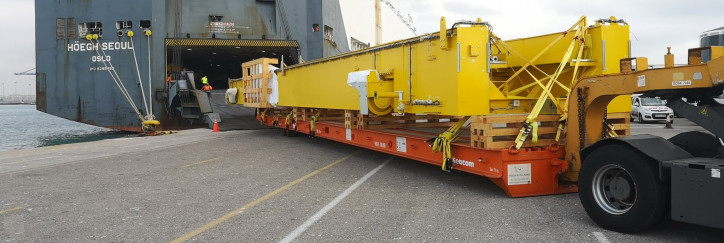Every breakbulk shipment is unique, and the more complex operations require meticulous planning. When Spanish Freight Forwarder, Sparber Group needed to ship a 30 metre-long rail transfer cart to meet a project deadline in Saudi Arabia, Höegh’s extensive experience in handling breakbulk cargo came to the rescue.

Transporting long out-of-gauge cargo is nothing new to Höegh Autoliners who frequently transport much longer units but each breakbulk shipment is unique and the more complex operations require meticulous planning. This shipment broke a record in Valencia for being the longest unit transported on a RoRo vessel and it had a deadline to meet.
Specialised equipment for breakbulk cargo
The Roll on and Roll off vessels, do as the name indicate, allow cargo to roll on and off, instead of being lifted. For breakbulk cargo that does not roll by itself, like the rail transfer cart, Höegh Autoliners use specialised rolltrailers to transport the cargo on and off the vessel.
Port Captain Roger Duran explain: “We have a range of rolltrailers that are designed to safely transport a wide selection of breakbulk cargo. As an example we have railed rolltrailers for trains and trams, super-low for high cargo, heavy-duty for heavy cargo and double-wide concept for the wider segment.”
Due to the length of the long rail transfer cart, the breakbulk operations team required the longer rolltrailers.
Identifying any critical points
When planning for breakbulk operations, Höegh Autoliners use software to simulate the cargo loading and discharging scenarios. The calculations offer a more realistic and calculated approach in the planning stage.
When the cargo operations team performed a close up verification of the entire loading process, they could see that the critical point would be in the angle of the ramp.
Roger clarifies: “When creating the drawings on how to stuff the rolltrailer, it became clear that there would be a considerable overhang and therefore a potential risk to hit the ramp during operations.”
Planning for safe breakbulk operations
The risk to hit the ramp would depend on the angle of the ramp and this can differ at load and discharge port, as the berths are different. To solve the challenge, the breakbulk operations team went back to the drawing board and calculated what the lowest ramp angle would be in both the load and the discharge port.
"With this at hand, we could determine the necessary ground clearance for the overhanging section, Roger explains."
Although the breakbulk operations team were now satisfied with the results in the simulations tool, they took extra precaution and added dunnage underneath the rolltrailer when it rolled over the critical point of the ramp.
Roger continues: “Wooden blocks of specific strength and height were placed between the cargo and rolltrailer to mitigate the risk and secure that we achieve the desired clearance.”
As part of the planning of the 30-meter long shipment, the breakbulk operations team created a ramp transit plan and a lashing and stuffing plan. During the actual loading operation, these documents were used as guides to secure that everything was performed in line with detailed planning.
Following the carefully calculated plans, the cargo was safely loaded on board Höegh Seoul ready for its sea voyage to Jeddah.
How will the rail transfer cart be used?
The rail transfer cart is used to move trains, and will be used in the maintenance of the Haramain high speed-rail network in Saudi Arabia. The fleet of high-speed Talgo trains are capable of operating at 300km/hr in the most inhospitable environment. Their unique designed and technical features guarantee the protection from sand and dust and extreme temperatures.
For more information, visit the Talgo website
Source: Höegh Autoliners